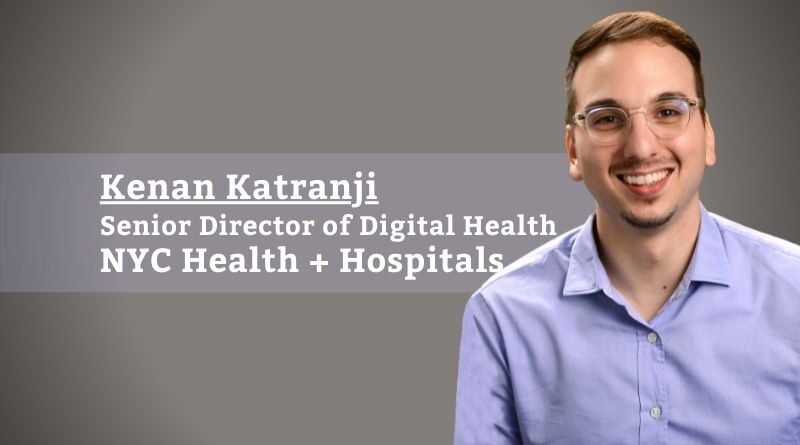The Digital Health Paradigm
By Kenan Katranji, Senior Director of Digital Health, NYC Health + Hospitals
Hospital At Home
The patient is 67 y/o M w/ PMH of DM2 discharged home from ED with CHF. The patient was sent home with a digital scale, glucometer, home O2 and enrolled in a digital health registry for asynchronous monitoring—the patient was given instructions for diuresis. Appointment made with home health video visit for installation support. Follow-up with PCP and Cardiologist in 2-4 days.
A discharge plan like this is probably not too far off. It may already appear in patient charts in one form or another in emergency rooms across the nation. Healthcare is creating a new digital health wave, catapulted to the forefront by the COVID pandemic. Digital health, in its most immediate form, began with video visits but has also ushered in the use of remote patient monitoring devices (RPM) and other forms of synchronous and asynchronous mediums.
Before the pandemic, the prevailing thought was that patient behavior was the most significant barrier to entry for digital health. Still, I believe what most of my colleagues have realized is that there is a surprising willingness for patients of all ages to participate in digital health. Patients are technologically resilient if you can show them value, and they don’t mind being liberated from the physical constraints of a PCP’s office or emergency room if it’s not necessary.
It has been an incredible journey to get us to this point. Various catalysts, both intentional (HITECH act) and non-intentional (COVID) have brought us to this point where the possibility of a hospital at home is on the horizon. In 2019 the Digital Health Market was estimated to be worth 89 billion, and it is estimated to have a compounded annual growth rate of 14.8% to grow to 220.94, according to Facts and Figures. Our role as healthcare leaders is to merge health data streams and unburden providers at the frontline rather than overload them. Below are a few of my thoughts on major topics in digital health.
Healthcare in Patients Hands
A prevailing sentiment from doctors managing a patient’s chronic illness is that the outcome is directly correlated to a patient’s effort to manage their chronic illness. This is where the high wire act begins as a provider balances rigid enforcement medicine with a compassionate understanding of medical management’s difficulty. An additional constraint compounding this difficult task is that you may only physically interact with a patient for about 20-30 minutes every six months. On the patient side, they are bombarded with new information, intense emotion, all while navigating a thicket of medical language. This relationship goes wholly dark as the patient walks out of the door. With Digital health interventions, patients care is no longer tethered to the office.
Today, the CDC estimated that 80% of heart disease and stroke, 80% of Type 2 Diabetes, and 40% of cancer are preventable. If only the provider can be in multiple places at once while also highlighting patients that need help. Telehealth and Remote Patient Monitoring (RPM) may be our key to reaching patients where the bulk of their care is administered – in their home. This access will shed light on a previously ambiguous portion of their care. With this newfound bi-directionality, digital health technologies can unlock endless possibilities for chronic care management.
Patient portals across many enterprises saw triple to quadruple the number of patient portal sign-ups during the COVID pandemic.
Digital Front Door
To help coordinate a patient’s interest in their digital health programs, an enterprise will need to build and maintain a patient portal of some kind that guides and provides access through their digital health ecosystem. This application replaces what would traditionally be a physical interaction a patient would have with a reception clerk at a hospital entrance. This digital space should be prominent, highly visible across the enterprise. Ideally, it is embedded in physical workflows to nudge enrollment and engagement at various checkpoints in acute and ambulatory settings.
Patients will engage with these services if they see the value. Patient portals across many enterprises saw triple to quadruple the number of patient portal sign-ups during the COVID pandemic. It was driven by the sudden increase in utility and value for a patient to be enrolled. As we expand the functionality of patient portals to provide other tools like direct patient scheduling and remote patient monitoring, my guess is we will see a widespread acceptance of digital tools and an increase in active use. These tools are what will empower our patients, give them agency, and unlock a fuller, more robust experience with health care.
Getting to Value
The future of Digital Health is bright, but in my career as an informatician, I’ve seen enough failed implementations of supposed “game changers” to temper my expectations. Healthcare is rife with snake oil and newfangled dashboards and devices that show incredible promise crop up at a mind-boggling pace. Plenty of providers are weary of the next new implementation and want to be left alone. The responsibility will fall on leaderships to be prudent and ensure proper steps are taken for technology at their site is safe, equitable, and valuable to the users in your health system (ideally, a technology offloads and does not add a task to the already over-burden providers). To maximize the success of new technology in a health system, patients and providers at all levels should be encouraged to get involved and make their voices heard; and leadership should build mechanisms for their voices to escalate. Designing healthcare workflows with the team members with skin in the game is essential in healthcare, moreso than any other industry, as the margins for error are slim. It’s important to be self-reflexive and agile to correct mistakes and adapt your plan to suit the needs of its users. It’s not clear what the future looks like. Still, the early adopters are already working on exciting new solutions that could change the paradigm of patient care – in the meantime, the late majority can elect to wait for the value from these digital health systems to shake out and parse through the solutions that make sense to their enterprise.



